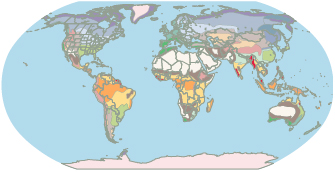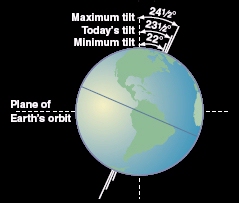|
Earth's Current Climate Regimes
German climatologist Wladimir Köppen (1846-1940) divided the world's climates into the following categories based on temperature and latitude:
A - Tropical
B - Dry
C - Moist Subtropical midlatitude
(mild winters)
D - Moist Continental midlatitude
(severe winters)
E - Polar
H - Highland
|

World Map illustrating Köppen classification scheme
click to enlarge |
|
Past Climates - the clues
 |
Climatologists study a variety of clues to better understand past climates and predict future climate change. Past climates can be divided into two main categories. Historical climate refers to the period when humans kept some sort of record of climate conditions. Paleoclimate refers to climate conditions that existed in the billions of years before the dawn of human civilization. Paleclimatology is the study of climates of the distant past. |
Historical Data
Diaries, logs, newspaper articles and other written records often include descriptions of the weather conditions. Rock paintings
also serve as historical data. For example, hippopotami and crocodiles on cave paintings in Sahara Dessert dating back between 5000 and 6000 BC suggest a much different climate than today.
Air Bubbles and Dust in Ice sheets
Bubbles of air trapped in ice provide windows to the past for chemists and climatologists. These trapped bubbles provide a record of the concentration of atmospheric gases such as carbon dioxide(
CO2) and methane(
CH4 ) over the past several hundred thousand years. Other climate clues frequently found in ice cores and glaciers include dust from volcanoes or storms and soil from erosion.
Marine Sediments
Materials have been deposited in layers on the ocean floor for millions of years. These deposits can include soil from wind erosion or floods, ash from volcanic eruptions, and shells of animals. In ocean sediments, the animal shells are primarily calcium carbonate (
CaCO3) which is extremely useful for tracking past climates by the relative amounts of oxygen atoms of different atomic weights. These oxygen isotopes, 16O and 18O, both occur naturally. The ratio of 18O to 16O provides clues to past climates. During colder climates there is a higher concentration of
18O in ocean water because the lighter isotope, 16O , evaporates more readily and ends up in snow and ice in glaciers. During warmer periods, marine animals have relatively more 16O available to form their shells and which settle on the ocean floor when they die their and provide a record of the isotope ratio.
Fossil Records
Fossils reveal ancient animal and plant life that can be used to infer climate characteristics of the past. They provide a means to track life through the ages because they an integral part of the rocks in which they are formed. The age of the rocks can be dated by radiometric dating techniques, providing evidence for climate extending back hundreds of millions of years.
|
 Click to learn more
Click to learn more |
Tree Rings
Climatic conditions and weather variations influence tree growth. The diameter of a tree trunk increases as the tree grows, typically adding one concentric ring each year. The width of these rings indicates how fast the tree grew during a particular period and is a function of moisture, temperature and solar radiation. For example, scientists can relate tree ring width to modern-day precipitation and estimate precipitation amounts for years prior to when weather observations were available.
Pollen Records
In addition to growth rings, trees produce pollen that can accumulate in a given area, such as a lake. Pollen degrades slowly and each species of pollen has a distinctive shape identifiable under a microscope. Although pollen grains do not give the same detailed year-to-year information that tree rings do, they are valuable in extending our understanding of climate back tens of thousands of years by radiocarbon dating of the pollen grains. |
Past Climates - the mechanisms
Volcanic eruptions, asteroid impacts and solar variability have all influenced Earth's past climate. But the biggest force behind climate change (prior to the industrial revolution) involves variations of the Earth's orbit and tilt. It turns out that the shape of Earth's orbit and axial tilt are not constant and that variations result in climate change. A Scottish janitor named James Croll first proposed this theory in the 1860s. Later, a Serbian engineer named Milutin Milankovitch while interned during World War I and allowed to work in the library of the Hungarian Academy of Sciences furthered Croll’s theory using a slide rule and four years of uninterrupted study. His explanation, known as the Milankovitch cycles, describes variations in Earth's orbit as follows:
|
Precessions
Earth wobbles on its axis about once every 26,000 years, similar to a spinning top. This alters the relationship between the solstices and the distance from Earth to the Sun. For example, 11,000 years ago the Northern Hemisphere summer solstice occurred at perihelion, when the Earth is closest to the Sun. (almost the exact opposite of today seasons) This "synching up" of summertime with perihelion made the differences between winter and summer much more pronounced. The phenomena of the solstices and equinoxes creeping slowly forward through the calendar year is now known as precessions. |
|
Eccentricity
The shape of Earth's orbit becomes more elliptical on time scales of about 100,000 years. At present the maximum difference between Sun-Earth distances during the years is only about 3% but over the past several hundred thousand years this number has been as small as 1%( a nearly circular orbit) and as large as 11%. |
|
Axial Tilt
The tilt of the Earth also changes slightly, with a dominant cycle every 41,000 years. The change in angle of inclination is only about 1° from the present tilt, from 23.5 to 24.5°. However, Earth's tilt is a critical factor in climate resulting in very large differences in solar radiation. Changes in Earth's angle with respect to the Sun often go by the name "obliquity". |
|
These three orbital variations take place simultaneously. LIke overlapping musical tones, these cycles create resonances that are not quite the same as the original cycles. The result is that the Earth's climate is affected by these Milankovitch cycles on four different periods: 19,000, 23,000, 41,000 and 100,000 years.
Widespread acceptance of Milankovitch’s theories occurred in the decades just after his death when investigations of sea floor sediments and the Vostok ice core exhibited periodicities matching his calculations. |






